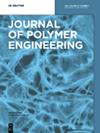Preparation and properties of acrylate/polyvinyl alcohol self-healing hydrogels based on hydrogen bonds and coordination bonds
IF 1.7
4区 工程技术
Q4 POLYMER SCIENCE
引用次数: 0
Abstract
Despite the widespread attention garnered by self-healing hydrogels in various fields, achieving a balance between high mechanical strength and self-healing capability remains a challenge. Particularly, the addition of fillers in the fabrication of spray-coated waterproof materials hinders the movement of molecular chains. Simultaneously, the self-repair of metal ions is hindered by issues such as a prolonged required time and low repair rate. Therefore, we introduce a polyvinyl alcohol (PVA) solution subjected to freeze–thaw cycles into the acrylic acid magnesium/calcium hydrogel system, creating a self-healing hydrogel with an interpenetrating polymer network (IPN). Due to the abundance of hydroxyl groups on the PVA molecular chains, during the freezing process, some PVA chains form microcrystals that do not dissolve upon thawing at room temperature. These microcrystals act as cross-linking points, connecting PVA chains into a 3D network. Consequently, the hydrogel, under the dual effects of hydrogen bonds and coordination bonds, exhibits excellent mechanical properties and the ability to self-heal at room temperature. Furthermore, by adjusting the concentration of the PVA solution, the mechanical properties and healing ability of the hydrogel can be tailored to meet various construction requirements.基于氢键和配位键的丙烯酸酯/聚乙烯醇自愈合水凝胶的制备及其特性
尽管自愈合水凝胶在各个领域受到广泛关注,但如何在高机械强度和自愈合能力之间取得平衡仍是一项挑战。特别是在制造喷涂防水材料时添加填料会阻碍分子链的运动。同时,金属离子的自我修复也受到所需时间长、修复率低等问题的阻碍。因此,我们在丙烯酸镁/钙水凝胶体系中引入了经受冻融循环的聚乙烯醇(PVA)溶液,形成了一种具有互穿聚合物网络(IPN)的自修复水凝胶。由于 PVA 分子链上含有大量羟基,在冷冻过程中,一些 PVA 分子链会形成微晶体,在室温解冻时不会溶解。这些微晶体可作为交联点,将 PVA 链连接成三维网络。因此,在氢键和配位键的双重作用下,水凝胶具有优异的机械性能和室温自愈合能力。此外,通过调整 PVA 溶液的浓度,水凝胶的机械性能和愈合能力也可以进行定制,以满足不同的施工要求。
本文章由计算机程序翻译,如有差异,请以英文原文为准。
求助全文
约1分钟内获得全文
求助全文
来源期刊

Journal of Polymer Engineering
工程技术-高分子科学
CiteScore
3.20
自引率
5.00%
发文量
95
审稿时长
2.5 months
期刊介绍:
Journal of Polymer Engineering publishes reviews, original basic and applied research contributions as well as recent technological developments in polymer engineering. Polymer engineering is a strongly interdisciplinary field and papers published by the journal may span areas such as polymer physics, polymer processing and engineering of polymer-based materials and their applications. The editors and the publisher are committed to high quality standards and rapid handling of the peer review and publication processes.
 求助内容:
求助内容: 应助结果提醒方式:
应助结果提醒方式:


